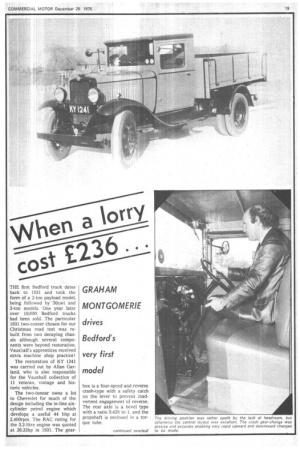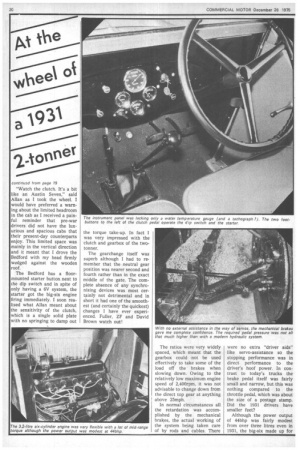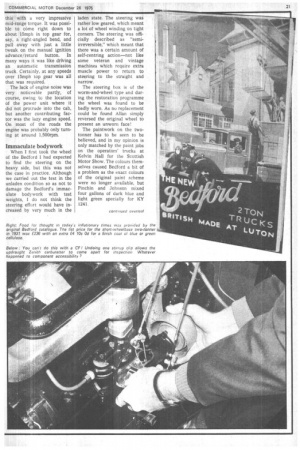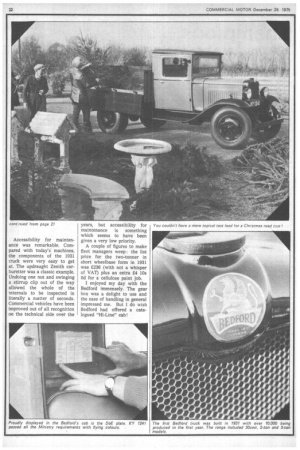Nisiben a lorry Cast 0.36 . • •
Page 21

Page 22

Page 23

Page 24

If you've noticed an error in this article please click here to report it so we can fix it.
GRAHAM MONTGOMERIE drives Bedford's very first model
THE first Bedford truck dates back to 1931 and took the form of a 2-ton payload model, being followed by -'30cwt and 3-ton models. One year later over 10,000 Bedford trucks had been sold. The particular 1931 two-tanner chosen for our Christmas road test was rebuilt from two decaying chassis although several components were beyond restoration. Vaux:iall's apprentices received extra machine shop practice!
The restoration of KY 1241 was carried out by Allan Garland, who is also responsible for the Vauxhall collection of 11 veteran, vintage and historic vehicles, The two-tonner owes a lot to Chevrolet for much of the design including the in-line sixcylinder petrol engine which develops a useful 44 bhp at 2,400rpm. The RAC rating for the 3.2-litre engine was quoted at 26.33hp in 1931. The gear box is a four-speed and reverse crash-type with a safety catch on the lever to prevent inadvertent engagement of reverse. The rear axle is a bevel type with a ratio 5.428 to 1, and the propshaft is enclosed in a torque tube. "Watch the clutch. It's a bit like an Austin Seven," said Allan as I took the wheel. I would have preferred a warning about the limited headroom in the cab as I received a painful reminder that pre-war drivers did not have the luxurious and spacious cabs that their present-day counterparts enjoy. This limited space was mainly in the vertical direction and it meant that I drove the Bedford with my head firmly wedged against the wooden roof.
The Bedford has a floormounted starter button.next to the dip switch and in spite of only having a 6V system, the starter got the big-six engine firing immediately. I soon realised what Allan meant about the sensitivity of the clutch, which is a single solid plate with no springing to damp out the torque take-up. In fact I was very impressed with the clutch and gearbox of the twotonner.
The gearchange itself was superb although I had to remember that the neutral gear position was nearer second and fourth rather than in the exact middle of the gate. The complete absence of any synchronising devices was most certain1S7 not detrimental and in short it had one of the smoothest (and certainly the quickest) changes I have ever experienced. Fuller, ZF and David Brown watch out! The ratios were very widely spaced, which meant that the gearbox could not be used effectively to take some of the load off the brakes when slowing down. Owing to the relatively low maximum engine speed of 2,400rpm, it was not advisable to change down from the direct top gear at anything above 25mph.
In normal circumstances all the retardation was accomplished by the mechanical brakes, the actual working of the system being taken care of by rods and cables. There were no extra "driver aids" like servo-assistance so the stopping performance was in direct performance to the driver's hoof power. In contrast to today's trucks the brake pedal itself was fairly small and narrow, but this was nothing compared to the throttle pedal, which was about the size of a postage stamp. Did the 1931 drivers have smaller feet?
Although the power output of 44bhp was fairly modest from over three litres even in 1931, the big-six made up for this with a very impressive mid-range torque. It was possible to come right down to about 15mph in top gear for, say, a right-angled bend, and pull away with just a little tweak on the manual ignition advance/retard button. In many ways it was like driving an automatic transmission truck. Certainly, at any speeds over 15mph top gear was all that was required.
The lack of engine noise was very noticeable partly, of course, owing to the location of the power unit where it did not protrude into the cab, but another contributing factor was the lazy engine speed. On most of the roads the engine was probably only turning at around 1,500rpm.
Immaculate bodywork
When I first took the wheel of the Bedford I had expected to find the steering on the heavy side, but this was not the case in practice. Although we carried out the test in the unladen condition so as not to damage the Bedford's immaculate bodywork with test weights, I do not think the steering effort would have increased by very much in the laden state. The steering was rather low geared, which meant a lot of wheel winding on tight corners. The steering was officially described as "semiirreversible," which meant that there was a certain amount of self-centring action—not like some veteran and vintage machines which require extra muscle power to return to steering to the straight and narrow.
The steering box is of the worm-and-wheel type and during the restoration programme the wheel was found to be badly worn. As no replacement could be found Allan simply reversed the original wheel to present an unworn face!
The paintwork on the twotonner has to be seen to be believed, and in my opinion is only matched by the paint jobs on the operators' trucks at Kelvin Hall for the Scottish Motor Show. The colours themselves caused Bedford a bit of a problem as the exact colours of the original paint scheme were no longer available, but Pinchin and Johnson mixed four gallons of dark blue and light green specially for KY 1241.
Accessibility for maintenance was remarkable. Compared with today's machines, the components of the 1931 truck were very easy to get at. The updraught Zenith carburetter was a classic example. Undoing one nut and swinging a stirrup clip out of the way allowed the whole of the internals to be inspected in literally a matter of seconds. Commercial vehicles have been improved out of all recognition on the technical side over the years, but accessibility for maintenance is something which seems to have been given a very low priority.
A couple of figures to make fleet managers weep: the list price for the two-tonner in short wheelbase form in 1931 was E236 (with not a whisper of VAT) plus an extra £4 lOs Od for a cellulose paint job.
I enjoyed my day with the Bedford immensely. The gear box was a delight to use and the ease of handling in general impressed me. But 1 do wish Bedford had offered a catalogued "Hi-Line" cab!




















































